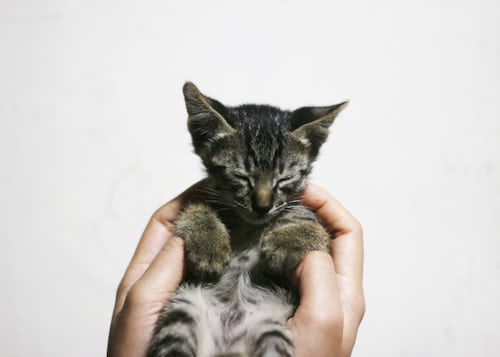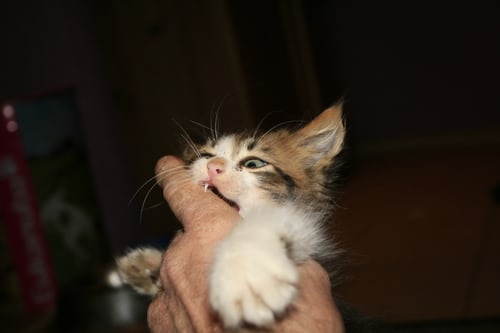Apart from house-soiling, feline violence is the second most common behavioral issue that causes owners to seek veterinary behavioral consultants. And unfortunately, violence is also one of the most common reasons why owners want to euthanize or get rid of their pet cat (again, just secondary to house-soiling). There are several different forms of attacks in cats, such as defensive, diverted, pain-induced, and even aggression. Have you ever wondered: why does my cat attack me when I pet him?
Unfortunately, aggression is not rare in felines; it is the second most common explanation for a visit to a behaviorist. In cats, sudden violence is a terrifying and frustrating issue for many owners who fear the unpredictable nature of kitty rage and the physical harm caused by an attack.
In addition to cat bites and wounds’ unpleasant nature, diseases such as cat scratch fever or severe bacterial infection may also be transmitted. Cat violence is not a matter of fun.
Why does my cat attack me when I pet him?

Unlike dogs, cats also have a poor tolerance for petting and can become over-stimulated easily. The amount of time it takes for petting to go from fun to unpleasant varies with the cat. But when it reaches that point, the cat responds almost as though it was injured or in pain. Animal behaviorists refer to it as petting-induced aggression.
Petting aggression tends to be most prevalent in young, active cats taken early from their litter and left alone for long periods of time during the day.
Smacking a cat may make the behavior worse, as most cats see physical correction as a challenge and will become even more violent during subsequent petting sessions. Petting attacks can be explosive and risky, particularly for well-meaning young children. Learn to recognize and prevent circumstances that may lead to this behavior.
Violence In Cats
While owners frequently report a cat attacking from nowhere, cats frequently display subtle body posture changes before beginning a real act of aggression. These postures could be a hint as to the cause for violent actions, as well as the much-needed warning of potential attacks.
Defensive postures are designed to make the cat appear smaller and defensively put itself. These postures may include: crouching, flattened ears, turning away from the human, hissing, swatting on you, raised hackles, or a tucked head. A protective cat is always feeling fear or anxiety about a situation that may or may not be obvious to you. You can be the victim of fear-based violence even though you’re not the one that triggers anxiety.
Aggressive postures make a cat look big and overwhelming. These postures include rigid legs, hackles raised, heading towards you, glaring at you, erect ears, groaning, and a rigid tail.
In any case, you want to avoid dealing with a cat showing these postures as they are on the verge of going on to the actual, dangerous gestures. An attack cat can move with surprising speed and violence, causing significant harm in a very short time when the mouth and all four paws are engaged.
Petting – Caused Violence

And, of course, there’s a petting-induced attack. Why does my cat attack me when I pet him? This is when unexpectedly after you’ve been petting him for a few minutes, your feline pal doesn’t seem so friendly anymore. Maybe he’ll give you a dirty look, nip or bite, and then he’ll run away. You’re left to ask, “why does my cat attack me when I pet him?”
Note, cats are rather sensory-oriented animals. They may enjoy being stroked and petted for a few minutes, but it becomes uncomfortable, even painful if it goes on for too long. Suppose someone was rubbing your arm or your back in the same place, and they just kept doing it, even though you want them to stop.
It’s the same thing with your cat. You really don’t know how frustrated he’s going to be. You think he loves being petted, but he’s getting more and more irritated until he eventually turns around and lets you have it.
Pay attention when you pet your animal. Stop the long strokes of your body, and let your cat direct your finger, as seen in the video, to choose where he or she wants to be petted. And always be sure that your cat will quit when he or she needs to.
More Information
Be alert to the actions of your pet. A cat sometimes bites when a person does not understand what he or she is trying to say. When your kitty tells you he’s had enough petting, for now, it’s best to listen to him. Otherwise, he could bring the point home with his teeth and claws.
Stop scratching the belly of your cat. This is the place that cats naturally defend. Instead, pet your friend behind her ears and under her chin.
How To Change The Offensive Behavior Of Your Cat
Your cat needs to understand that it can’t bite you or be violent towards you. It’s up to you to teach your cat a few ways by showing him that being petted is a privilege, not a right.

Petting sessions
If your cat wishes to be affectionate, let it sit in your lap and softly pet it around your head and ears. Don’t hold him back. After a short time, and before he begins to display signs of agitation, place him back on the floor and play with him or give him a treat or a toy. Make every petting session a little longer before you put it down and play with it.
Look at the signals.
Watch the language of his body. If he starts giving you the sidewise look and starts twitching his tail, finish the session before he can bite you. If he succeeds in biting or assaulting you, dump him off your lap and make him wait a while before you let him come back. He wants to get the message you’re in charge of. Your cat will never be a cute, cheesy lap baby, but with time and patience, you can strengthen your relationship with your formerly evil cat.
Prevention
As long as you bite and scratch the job, your cat will continue to use it to monitor contact. Render these actions unnecessary by avoiding situations that lead to them and/or controlling the circumstances so that the cat never gets a chance to bite or use its claws.
Be persistent, though, and practice hard love. If you give up before you set the ground rules for petting and violence, you will have to start conditioning from square one.
And note that a pet’s bad behaviors always get worse right before they go away, so your cat is working harder to get the previously good activity to function again. Behaviorists call this an extinction outburst, and when it occurs, it means you’re on the right track.
Petting threshold
Why does my cat attack me when I pet him? Cats take care of other cats on the head and neck. But the full-body strokes a person can feel inappropriate and make the cat nervous or nervous. It’s this feeling of unease that triggers the bite.
Limit your petting to the head or neck of the cat. Identify the threshold for petting. In other words, count the number of strokes that your cat allows before you attack; pay careful attention to its body language so that you can avoid petting before the cat bites.
It may be three strokes, five, or more. When you’ve established the cap, stop until the cat attacks so that you can monitor the interaction. This is the secret to changing this behavior: to let the cat know that you are in control of the situation.
As you cross the threshold of petting, if the cat is sitting on your lap, don’t force it off, or you might be caught in an attempt to attack your paws. To put an end to the petting, stand up and dump the cat without touching it. Don’t play with a cat that could scream to get your attention. Other cats can run away and sulk in this situation.
Use the positive reinforcement function.
The goal in these circumstances is to show the cat that all the good things in life (play, food, attention) have to be won and that you call the shots. Then rewards and services can be used to encourage the cat to react properly.
For example, teach the cat to “come” by taking advantage of dinnertime.
Before the cat gets the food bowl, say “come” in a happy, loud voice, then turn on the can opener, shake the kibble container, or pick up the treat jar. Your cat has already learned these cues and what time to run to its bowl, so you’re just teaching it to equate the coming command with the action. When the cat obeys, reward it with a meal or a bowl of food.
You may also use a clicker to train your cat by combining food treats with a clicker that creates noise. Eventually, your cat may begin to think of the clicker as a reward, and treats will no longer be appropriate.
Use a treat or toy to coax your kitty out of the furniture or out of the way instead of moving or raising it, which places your hands within the strike zone. Say “go” and dump the treat on the board, or tempt the cat down with a feather.
If the cat is in your chair, tilt it or shake it to get the cat to quit on its own. Eventually, you’re just going to have to say the word shift and make a sweeping gesture of obedience to the cat — and you’ve prevented an interaction that would otherwise lead to a bite.
Desensitization
Finally, if you like, you can de-sensitize the cat and enhance its petting tolerance. If you make three strokes in front of your ears and a tail signal discomfort, add one more stroke, combined with a reward like a clicker, then stop and dump the cat off your lap before it can bite. By adding one stroke each week, you will raise your threshold over time while avoiding your teeth.
Understanding How The Cats Interact

Before we speak about improving feline biting actions, though, you need to translate a little Urdu into French. When a cat gets over-stimulated by petting, she’s basically telling you she’s had enough – if you’re talking her language.
The Body Language Of Feline
The tail is the most visible symbol. Dogs pound their tails back and forth when they are pleased. Cats are offering a slow-twitch of the tip of the tail. If the whole tail gets active, swiping back and forth – that’s a warning. Also, watch your eyes. The cool, relaxed cat’s pupils will be narrow. If they’re dilated, the stimulation tank is full. Watch the hair on the back and the back of your head, too.
If the ridge is standing – or the skin is rippling – the cat is telling you, too, in cat-speak, it’s over. It’s like someone once said to me after seeing the Amityville Horror — you remember when your house tells you to “get out”—get out! When the cat tells you that she’s done, let her be. If she’s in your lap, stop touching her.
Petting A Cat Properly
If you approach her, focus on her head, the sides of her face, and the back of her neck. Keep away from full-bodied petting — you can eventually get there, but don’t try it at the beginning. A lot of cats are becoming more sensitive to their tails – you may have seen a cat that would stick its rump in the air if you petted it at the base of the tail – that’s a high stimulation spot. Often, the closer you get to the back of your head, the harder it is to whip around and bite you.
What do I do if my cat is exhibiting sudden aggression?
The first stop every time a cat displays these offensive signs with no apparent provocation is your veterinarian. She will inspect your cat to make sure it doesn’t have a medical problem that triggers inappropriate behavior. If your cat has a clean bill of health, your veterinarian will refer you to a behavioralist who can help identify the causes of the aggression and the measures you can take at home to fix the problem.
Final Words
In certain situations, merely being aware of the early signs of a cat about to freak out gives you a chance to get out of the situation before it escalates to abuse. Although you can’t always monitor the causes of anxiety, owners should always allow the cat the room it needs to cool down without upsetting anyone. With persistence and some good detective work, many cats are soon back in any good grace.

